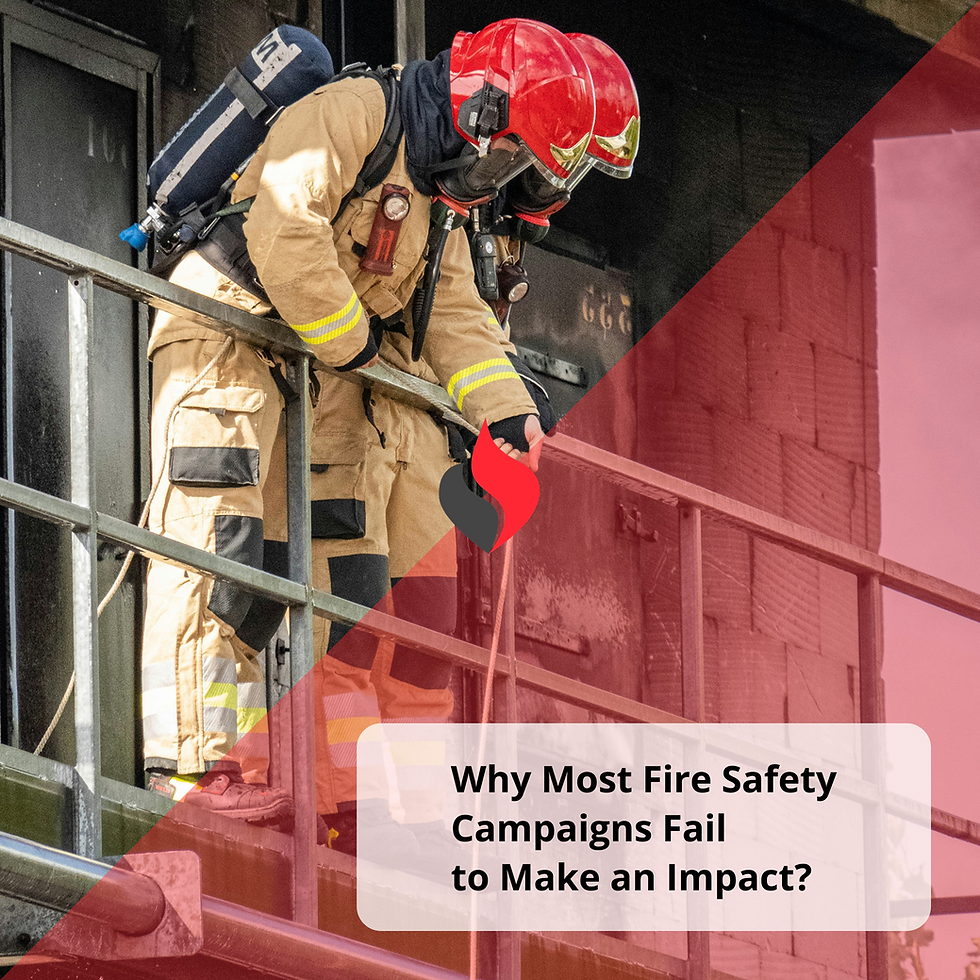Why Most Fire Safety Campaigns Fail to Make an Impact
- Pavlo Lapikov

- Jul 21
- 4 min read
Updated: Dec 2

Article Overview:
Every year organizations invest in fire safety campaigns, yet many fail to change behavior or reduce risk. The problem is not effort, it is alignment. Effective fire safety campaigns must connect codes with human behaviour, workplace realities, and clear communication strategy. This guide explains why many fire safety campaigns fall short and how to design programs that actually protect people.
Table of Contents:
Why Do Fire Safety Campaigns Fail Without Consistent Messaging?
How Do Fire Safety Campaigns Account For Human Behavior Under Stress?
Why Do Fire Safety Campaigns Need Industry-Specific Content?
What Elements Make Fire Safety Campaigns Effective In Practice?
Why Do Fire Safety Campaigns Require Ongoing Support From Leadership?
How Should Fire Safety Campaigns Be Measured And Improved?
FAQs
Why Do Fire Safety Campaigns Fail Without Consistent Messaging?
Fire safety campaigns often appear once a year, then go quiet. Fire safety is not seasonal, it is cultural. The National Fire Code of Canada requires training that is relevant to each workplace, yet many small businesses never reopen after a major fire. Consistency matters because memory fades, turnover happens, and procedures drift.
How Do Fire Safety Campaigns Account For Human Behaviour Under Stress?
People do not follow posters during an alarm, they follow habits. Fire safety campaigns that rely on passive signage overlook stress responses like freezing, following others, or taking the path they know rather than the safest route. Action-based drills, short scenario videos, and clear role assignments create automatic behavior when it counts.
Why Do Fire Safety Campaigns Need Industry-Specific Content?
Generic fire safety campaigns miss real hazards. A clinic, a warehouse, and a childcare center face different risks, routes, and roles. Align your fire safety campaigns with your occupancy type, fuel loads, staffing patterns, and code obligations. Tailored messaging reduces confusion, speeds evacuation, and improves inspection outcomes.
What Elements Make Fire Safety Campaigns Effective In Practice?
Effective fire safety campaigns move people from awareness to action. They are simple, specific, and measurable. Reference local code requirements, such as annual evacuation drills, and embed them in a training calendar. Use plain language, consistent icons, and floor-specific instructions.
Checklist For Fire Safety Campaigns:
Start with a site-specific fire risk assessment
Schedule both announced and surprise evacuation drills
Assign and train wardens with clear duties and backups
Keep exits clear and mark routes with compliant signage
Provide short refresher micro-lessons during staff meetings
Record all drills, inspections, and training for audits
Why Do Fire Safety Campaigns Require Ongoing Support From Leadership?
Without leadership time and resources, fire safety campaigns fade into background noise. Leaders should open drills, approve training hours, and ask for metrics. Incorporate fire safety talking points into monthly meetings, onboarding, and contractor briefings. Visible leadership attention signals that fire safety campaigns are a priority, not a poster.
How Should Fire Safety Campaigns Be Measured And Improved?
Measure what changes behavior. Count attendance, but focus on outcomes: faster evacuation times, fewer blocked exits, better route selection, and first-30-days training for new hires. Track corrective actions from inspections and close the loop. Use short pulse surveys to confirm knowledge retention. Improve what underperforms, then communicate the win so people see progress.
If you need a practical measurement framework, listen to analytics discussions on the Fire Safety Philosophy Podcast. To implement dashboards and communication kits that align with your KPIs, visit Fire Heart FSMA Services.
FAQs
1. How often should an organization update its fire safety campaign?
Fire safety campaigns should be refreshed at least every 6 to 12 months to stay aligned with code requirements, staffing changes, and workplace risk evolution. Annual campaigns are not enough because turnover, new equipment, and procedural drift erode readiness. Regular micro-updates help reinforce habits year-round.
2. What is the best way to communicate fire safety information to employees?
Use short, simple, multi-format communication: posters, floor-specific instructions, brief videos, toolbox talks, and micro-lessons built into existing meetings. Redundancy improves retention, especially in workplaces with shift work or high turnover.
3. Why do employees forget fire safety procedures so quickly?
People forget when information is not repeated or practiced. Stress also shuts down rational recall, which is why drills, muscle memory, and clear role assignments are essential. Without ongoing reminders, even well-trained staff revert to familiar but unsafe routes during an alarm.
4. How can small businesses run effective fire safety campaigns with limited resources?
Small businesses can focus on essentials: one annual evacuation drill, quarterly micro-reminders, clear exit signage, and simple task assignments for staff. Free or low-cost tools like checklists, one-page instructions, and short videos can still create a strong safety culture when applied consistently.
5. What metrics show that a fire safety campaign is actually working?
Key indicators include reduced evacuation times, improved route selection, fewer blocked exits, faster alarm recognition, and higher completion rates for new-hire training. Tracking corrective actions from inspections and addressing them quickly also demonstrates real program effectiveness.



Comments